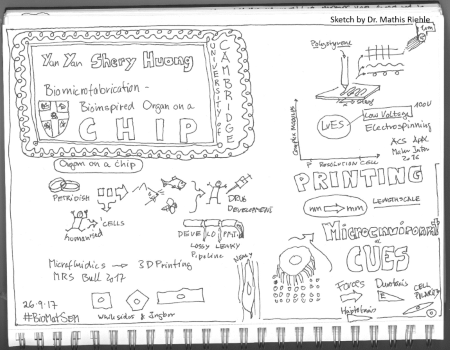The 'Biointerface' research group centres on bioengineering research, focusing on multiscale biofabrication, 3D bioprinting, and developing biomimetic organ-on-chips.
Living tissues are intricate ensembles of multiple cell types embedded in a complex, but well-defined extracellular matrix (ECM) of topographical and adhesive features ranging from nanometres to micrometres. Cell ladened ECMs act like units of reaction centres and information hubs. Corporation between these small units lead to a hierarchical structure (i.e. human body parts) achieving homeostasis (balance).
Our research is highly multi-disciplinary in nature, crossing fields of engineering, biology, chemistry, polymer physics and computer science. We aim to translate our scientific findings into exploring a new generation of tissue engineering constructs for personalised therapy, at affordable costs; and to provide new technologies for understanding human biology or for drug testing, and ultimately leading to sustainable healthcare.
Group Leader
Prof. Yan Yan Shery Huang, FIMMM
Academic Division: Mechanics, Materials and Design
Telephone: +44 1223 7 48559
Email: yysh2@eng.cam.ac.uk
Personal Webpage: http://www.eng.cam.ac.uk/profiles/yysh2
Group Members and Associates
- Adithya Vivek (PhD student); Artificial motility
- Yaqi Sheng (PhD student); Organ model and tissue engineering.
- Marzia Calcagno (PhD student); Functional fibre printing for biomarker detection
- Yuan Shui (PhD student); Functional fibre printing for biointerface
- Jack F. Murphy (PhD student, co-supervised with Dr Xuan Li)
- Jenny Hsin (NIH/Oxbridge PhD student, co-supervised with Dr Laura Kerosuo Pahlberg)
- Stanley Ka (PhD student); Functional fibre printing for biointerface
- Joshua Weygant (PhD student, co-supervised with Emma Rawlins); Organ-on-a-chip
- Shuyu Lyu (PhD student); Biohybrid systems
- Haydn Cheong (MPhil/ PhD student; co-supervised with Prof Daping Chu)
- Betty Li (MPhil/PhD student; co-supervised with Prof Andras Lakatos)
- Kadidia Sylla (Yale Robert G. Bates Fellow)
- Dr Ali Doryab (DFG German Research Foundation Fellow)
- Dr Ellen Wrobel (FAPESP Post-doc Fellow)
Alumni
In no particular order:
- Junting Huang (MPhil student)
- Joshua Van Zak (PhD student); Functional fibre printing for biointerface
- Dr Kaiyuan Zhu (visiting postdoc academic from East China University of Science and Technology)
- Dr Liang Ma (Associate Professor, Zhejiang University)
- Julian Gonzalez Rubio (visiting researcher from RWTH-Aachen Germany)
- Yifei Pan (PhD student); Bioelectronics printing
- Andy Wang (Research Associate); Functional fibre printing
- Ruishan Liu (PhD student); Organ on a chip model
- Iek Lei (PhD student, with Dr Mark Birch); Organ on a chip model
- Duo Zhang (PhD student); Organ on a chip model
- Dr Harvey Shi (Research Associate); fibre sensors
- Dr Saeed Fathi (Part-time Research Fellow); Cell printing
- Ed Cozens (Research Associate)
- Dr Yang Cao (Research Associat)
- Jenny O'Dowd (MPhil student); Cancer model
- Dr Lingqing Dong (Visiting scholar from Zhejiang University)
- Ye Liu (PhD student); Organ on a chip model
- Magda Gerigk (PhD student); Biomimetic niche of glioblastoma
- Dr Magali Ferro (Research Associate); Nephron on a chip
- Dr Karim Ouaras (Research Associate); Fibre printing
- Dr Pooya Davoodi (Research Associate); Chemical fibres
- Lizzie Gill (PhD student); Bioprinting of mini tissues
- Keval Patel (NIH-Oxbridge PhD program)
- Zhaoying Li (PhD student); Membrane-based biointerface
- Xia Li (PhD student); Electrojet writing of biointerfaces
- Cristina Bertulli (PhD student); Transendothelial migration in a microvessel-chip
- Nicholas Piano (MRes)
- Lukas Vasadi (MRes in Engineering)

